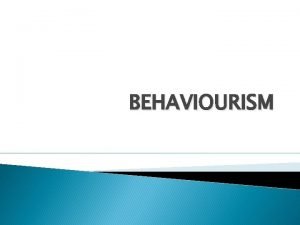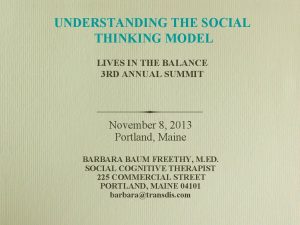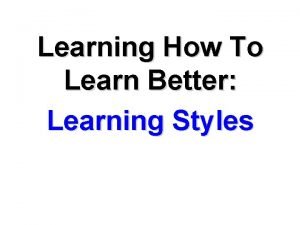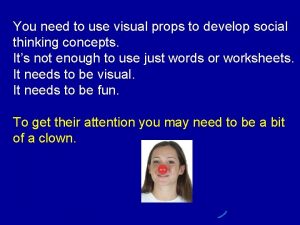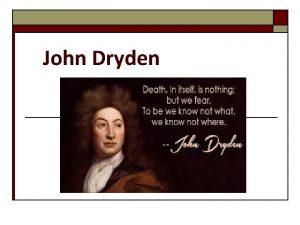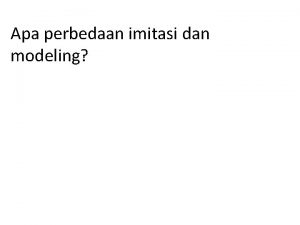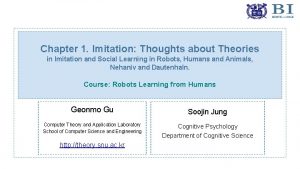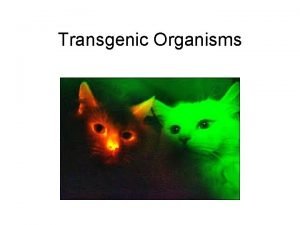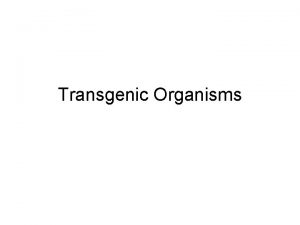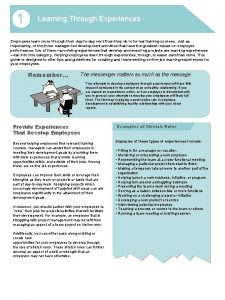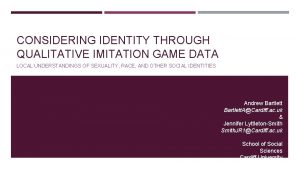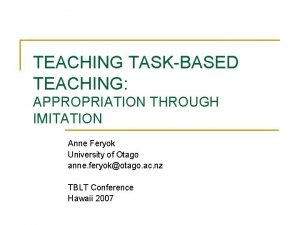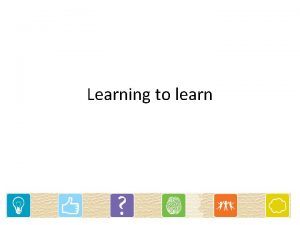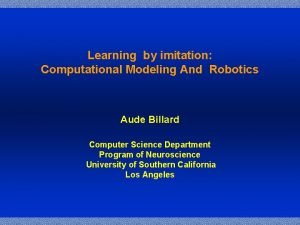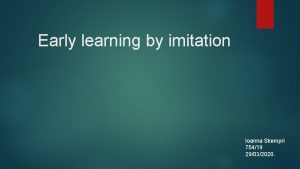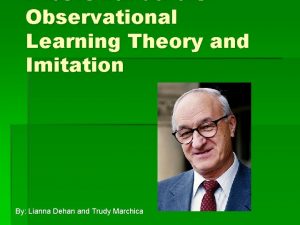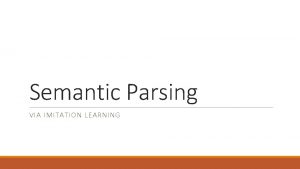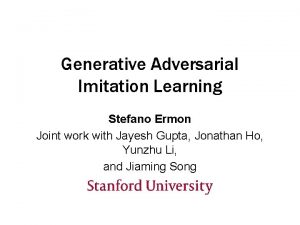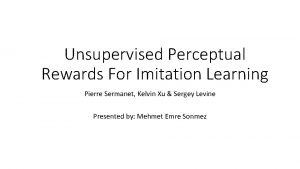Social Learning Imitation Overview Organisms learn through imitation


























- Slides: 26

Social Learning / Imitation

Overview Organisms learn through imitation based on the observation of others. Occurs within a variety of organisms Birds, Big Cats, Primates, Humans, etc. Major theorist Bandura Wide variety of studies examining the model

Overview Continued A model stimulus is presented in an effort to evoke the imitative behavior The imitative behavior follows immediately The model and behavior should formal similarity The model must serve as a controlling variable for the imitative behavior (SD)

Variables Influencing Imitation

Reinforcement If the model is rewarded, increased probability the observer will do the behavior. If the model is punished, increased probability the observer will not do the behavior.

Characteristics of the Model Age of the model Sex of the model If the model is seen as strong or weak People imitate models that appear powerful

More Variables Way the model is presented TV = Real life

Formal Similarity The model and the behavior physically resemble each other Closer the appearance, the higher the likelihood the observer will follow the model’s behavior

Immediacy The temporal relation between the model and the occurrence of the imitative behavior is very important Imitation may also occur at later times and in the context of everyday life situations However, when this occurs in the absence of a model, it is not imitation The discriminative features of the environment are different in this context (i. e. , the model is not controlling the behavior)

Controlled Relation The controlling relation between the model and the imitative behavior is paramount Best evidenced when the model is novel and it still evokes an imitative response After this first occurrence, the new behavior has a history of reinforcement Becomes a discriminated operant

Types of Behavior Modeling Planned models Pre-arranged antecedent stimuli that help learners acquire new skills Shows the learner exactly what to do Unplanned models Occur in everyday social interactions

Imitation Training Some children with disabilities require instruction in order to learn to imitate Objective: Teach children to “Do what the model does” Generalize a rule to imitate models Also known as generalized imitation

Steps to Imitation Training Assess the behavior in the observer you want to change Select potential modeling behaviors for training Assess prerequisite skills needed by the observer Train the model Pretest the behavior to be modeled Sequence modeling behaviors for training Perform imitation training Monitor the behavior

Assess the Behavior Need to determine the frequency of the behavior to be changed May need to identify stimuli, etc. May do a functional analysis, etc.

Select Potential Modeling Behaviors for Training Begin with selecting about 25 Depending on the observer, may need to include gross and/or fine motor behaviors Examples Movement of body parts Manipulation of physical objects Use only one at a time (don’t sequence them--save sequences for later)

Assess Prerequisite Skills Needed by the Observer What Prerequisite skills are needed by the observer? Attending (staying seated, keeping hands in lap, looking at teacher when name is called, looking at objects when prompted by teacher) Some problem behaviors that may interfere with training may need to be decreased before imitation training begins.

Train the Model What skills are needed Know what you want to train

Pretesting Is different from the initial assessment Purpose: To determine if individual already imitates some behaviors to be modeled Procedures: Get learner in “ready” position If object to be used, please it in front of individual Say learners name, and then “do this” Present the model Immediately praise all responses with formal similarity to the model Record learner’s response as correct or incorrect

Sequence the Behaviors to be Modeled Arrange from easiest to most difficult First models for training are ones the individual imitated correctly on some, but not all, pretest items Next: Teach ones the learner approximated but did incorrectly on pretest Last: Teach items the learner did not perform or performed incorrectly on pretest

Performing Imitation Training Pre-assessment Training

Pre-assessment Purpose: Evaluate learner’s current performance level and determine progress in learning to respond to model Procedure: Brief pretest prior to each training session Use first 3 models currently selected for training Present them 3 times in random order If learner performs them correctly 3 times, remove from training sequence

Training Use repeated presentations of 1 of the 3 models in pre-assessment Use model most often responded to or responded to with closest similarity during pre-assessment Continue until learner responds correctly 5 consecutive times Use physical guidance if necessary to prompt the response Gradually fade prompts as quickly as possible

Behavior Monitoring - Post-Assessment Purpose: Evaluate how well learner can perform previously- and recently-learned behaviors Present 5 previously learned models and 5 models still in training On 3 consecutive post-assessments If child has imitated a model incorrectly on 14 of 15 trials, remove it from training Physical guidance may be used

Behavior Monitoring - Probes for Imitative Behavior Purpose: Assesses for generalized imitation Select 5 non-trained, novel models to check for occurrence of imitation Do at end of each training session or intermix in training sessions Use pre-assessment procedures (no antecedent or response prompts)

Guidelines for Imitation Training Keep training sessions active and short (10 -15 minutes, a couple times a day) Reinforce both prompted and imitative responses Pair verbal praise and attention with tangible reinforcers If progress breaks down, back up and move ahead slowly Keep a record Fade out verbal response prompts and physical guidance

Conclusions Excellent way to train behavior Can be used in a wide variety of settings Can be used with a wide variety of populations Students Managers Counselors Assessment is critical Can include a variety of additional techniques Shaping
 Organisms learn about the consequences of behavior through
Organisms learn about the consequences of behavior through Chapter 7 motivation concepts
Chapter 7 motivation concepts Why do organisms interact with other organisms
Why do organisms interact with other organisms Unicellular and multicellular.
Unicellular and multicellular. Kinesthetic learner
Kinesthetic learner Learning english through popular culture
Learning english through popular culture Paired statement keys
Paired statement keys Do children learn through correction and reinforcement
Do children learn through correction and reinforcement Learning english through movies
Learning english through movies Telegraphic stage examples
Telegraphic stage examples Cuadro comparativo e-learning m-learning b-learning
Cuadro comparativo e-learning m-learning b-learning Early years learning framework overview
Early years learning framework overview Social thinking social communication profile
Social thinking social communication profile Learning to learn
Learning to learn Learning how to learn
Learning how to learn Social thinking and social influence
Social thinking and social influence Social thinking social influence social relations
Social thinking social influence social relations Udinus learn social
Udinus learn social Innateness theory of language
Innateness theory of language Humorous imitation
Humorous imitation John dryden metaphrase paraphrase imitation
John dryden metaphrase paraphrase imitation Imitation hypothesis
Imitation hypothesis Modeling and imitation training aba
Modeling and imitation training aba Modeling and imitation
Modeling and imitation Variegated babbling
Variegated babbling Imitation stage sociology definition
Imitation stage sociology definition Imitation by chimamanda ngozi adichie
Imitation by chimamanda ngozi adichie
